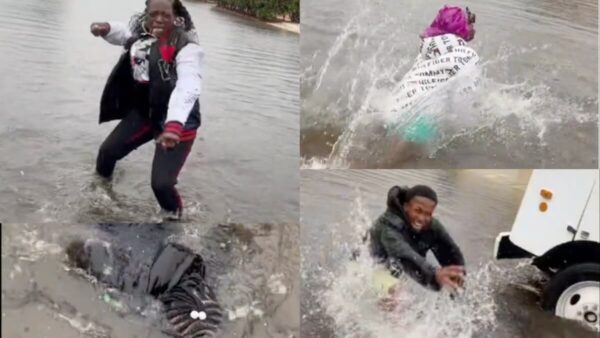While most residents in Southern California were doing their diligence to stay safe during Tropical Storm Hilary, some saw it as an opportunity to play around in the floodwaters and upload their shenanigans to TikTok. The footage has now gone viral, but for all the wrong reasons.
Hilary pummeled the region on Sunday, making history as the first storm to hit the region in 84 years. It produced heavy rain and flooding, sinkholes and mudflows, according to a report by NBC News. It also broke single-day rainfall total records for some cities.
Originally a category 4 hurricane, Hilary was downgraded to a tropical storm before drenching San Diego, Palm Springs and the rest of Southern California with intense rain and flooding. Officials said the situation was still “life-threatening,” despite no loss of life being reported at the time of publication.

“We are not out of the woods yet,” Brian Ferguson, deputy director of the California Governor’s Office of Emergency Services, told CBS News on Monday. “The back end of this storm is still impacting us. We could still see mudslides today as that ground gets saturated.”
In an 18-second video, some people can be seen dancing, swimming, jumping and flipping in the floodwaters. While they are all smiles and likely believe they are finding a silver lining in the catastrophe, social media users pointed out how dangerous being immersed in floodwaters is.
“Please stay out of floodwater,” HuffPo editor Philip Lewis tweeted, along with links to warnings from the Centers for Disease Control and Prevention and the Environmental Protection Agency about the health risks.
“Floodwater and standing waters can be dangerous and can make you vulnerable to infectious diseases, chemical hazards, and injuries.,” the CDC states. The EPA advises storm victims to “avoid or limit direct contact with contaminated flood water.”
Another Twitter user wrote, “the girl that was swimming in floodwater should be taken to urgent care immediately… hell all of them do.”
“Even people that live in flood areas don’t always know floodwater is f—ing nasty but I feel like there should be PSAs when places that don’t get floods have them bc like….it’s so nasty do not f—ing play in it.,” a third added, noting it also contains debris and the possibility of electrocution.
This is not the first-time kids have played in dangerous floodwaters. In 2019, Tulsa, Oklahoma, Mayor G.T. Bynum said parents “ought to be ashamed” after hearing reports of children being allowed to play in floodwater. Neither are isolated incidents.
Ignorance aside, the kids recording themselves playing in floodwaters speaks to a more prominent and disturbing trend: doing dangerous stunts in hopes of getting 15 minutes of fame.
Since TikTok came on the scene in 2016, it has become increasingly popular and home to many viral challenges. Unfortunately, some of these challenges have been dangerous and users have been hurt as a result of attempting to complete them.
Others have inflicted self-imposed harm on themselves in an attempt to garner likes and views. Though they succeeded in going viral, some of the people in the most popular cases now say it was not worth the cost.
In 2021, Tessica Brown ended up hospitalized after she uploaded a video of herself sharing she was having trouble removing Gorilla Glue from her hair. She’d used the strong adhesive after running out of her regular hair glue and eventually had to go to a renowned Black doctor in Los Angeles to get it removed after her local hospital and personal attempts failed.
She also said she experienced everything from being inundated with hateful comments to her daughter getting bullied at school over her ordeal.
In April, 16-year-old Mason Dark severely burned nearly 80 percent of his body while attempting to do a spray-paint challenge for TikTok with his friends. A well-liked football player, his mother described him as “unrecognizable”, and doctors said he would have a months-long recovery.
He cautioned others not to follow in his footsteps. “Don’t do stupid things. Don’t try new things. Don’t try to be different and make and impact and try to go viral,” Dark warned in a May interview with ABC11.
Currently, there’s NyQuil Chicken Challenge trending, which includes pouring the medicine over chicken and consuming it. The Food and Drug Administration has warned against it.
Other challenges have included encouraging users to steal and wreck cars, lick ice cream in supermarkets and put the containers back for unsuspecting shoppers, walk across milk crates and even hang themselves.
The latter, dubbed the Blackout Challenge, took the life of 9-year-old Arriani Arroyo in February 2021. Her younger brother said they’d been playing a game like they saw on TikTok.
These are just a handful of examples, but there are more. Yet people continue to record themselves doing dangerous things in hope of achieving TikTok fame. One TikTok user even named their account “my 15 minutes of fame I want it.”
Aside from the physical dangers, experts have warned the addiction to TikTok fame can also harm users emotionally, with children being particularly vulnerable.
“We’ve had cases of child stars in different eras and different times. But this is a more enhanced and hyper version of that,” Dr. Ciarán Mc Mahon, the author of “The Psychology of Social Media,” told Insider. “I don’t know how that will work out, but history would suggest that it’s not going to be pretty.”
Psychologist Dr. Pamela Rutledge echoed that sentiment, noting since cognitive judgment skills that allow us to make rational decisions are not fully developed before 25, the effects on kids are even more harmful. “Everyone wants to be famous. But in fact, for most of us, that’s not the real world,” Rutledge said.
This evidence suggests that either some TikTok users don’t know or don’t care about the dangers chasing social media fame pose. Therefore, it is incumbent upon those who do to raise awareness to try and prevent tragedies like the ones detailed above.
Again, there is the question: Is 15 minutes of TikTok fame worth risking your life? We’d say the answer is a resounding “No!”


